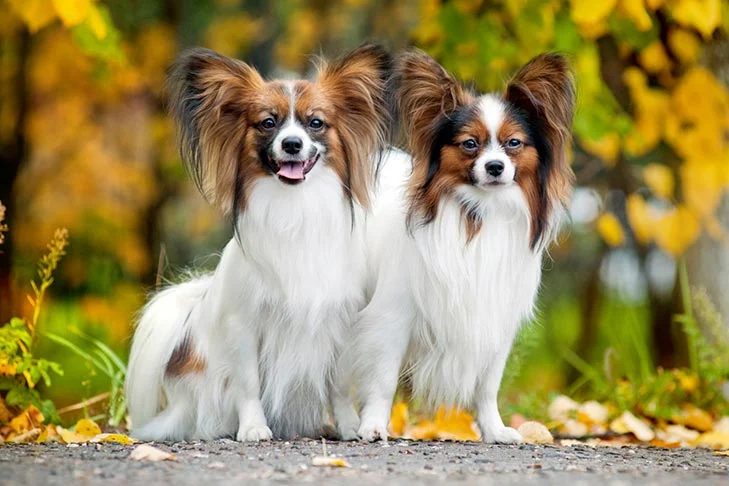The quick-witted, inquisitive Papillon is an adorable toy dog with cheerful athleticism. The Pap is a true “doggy dog,” blessed with a strong constitution, despite his elegant appearance. Fans of the Papillon describe it as cheerful, alert, and sociable. A tiny dog, measuring 8 to 11 inches at the shoulder, you can still spot a Papillon a block away thanks to the large, wing-shaped ears that give the breed its name (‘papillon’ is French for ‘butterfly’). Some Paps have erect ears, whereas others—the Phalene type—have down ears. Paps have a long, silky coat that has a variety of colors, with white serving as the basic color. They are petite and graceful with plumed tails. Paps are small dogs for all occasions and seasons, however, they are stronger than they appear. They do well in hot or cold climes, in cities or in the countryside, and they love to participate in family activities. They make great agility dogs and consistently place first at the top levels of the sport; less ambitious owners can teach them a variety of skills.
Papillon
Average sizes and life
expectancy of the breed.
Height
8-11 inches
Weight
8-11 inches
Life Expectancy
14-16 years
Breed Traits & Characteristics
About the Breed

Owning a dog is not just a privilege; it’s a responsibility. They depend on us for, at minimum, food and shelter, and deserve much more. When you take a dog into your life, you need to understand the commitment that dog ownership entails.
 Health
Health
Recommended Health Tests From the National Breed Club:
- Patella Evaluation
- Cardiac Exam
- Ophthalmologist Evaluation
 Grooming
Grooming
For a breed with long, silky hair, Papillons needs surprisingly little grooming, mostly because they do not have an undercoat. Grooming every month or so is fine. Between full grooming sessions, you might want to spend a few minutes running a comb or soft slicker brush through the hair inside the hind legs, behind the ears, and on the "culottes," or thigh hair, as mats tend to form there. A Papillon will need a bath every few months, or when he or she gets especially muddy or dirty. The Papillon's nails grow quickly and should be trimmed regularly'¿especially the dewclaw, which can curl around and pierce the leg. Finally, regular tooth brushing is vital for dental health.
 Exercise
Exercise
 Training
Training
 Nutrition
Nutrition
History
Papillons were initially developed as adoring and devoted companions for aristocratic women, and for hundreds of years, these adorable lap warmers were a major favorite in the royal courts of Europe. They can be seen in a lot of the most well-known painters in Europe’s portraits of ancient queens and princesses. Artists including Rubens, Rembrandt, Goya, and Toulouse-Lautrec painted Papillons, among others. In keeping with the Renaissance craze among nobles for miniature copies of their favorite breeds, paps were created by fusing existing toy breeds with spaniels (the breed’s early progenitors were known as “dwarf spaniels”).
These delicate dynamos are among the more athletic and biddable toy dogs in the canine kingdom, which may be due to the sporting-spaniel blood in the Pap’s history. The breed has a rich French heritage thanks to enthusiasts like Madame de Pompadour, Louis XIV, and Marie Antoinette (whose Pap, Thisbe, faithfully stayed outside the jail where the unfortunate queen awaited beheading). But Paps were developed and made well-known in the early breeding hubs of Italy and Spain.




